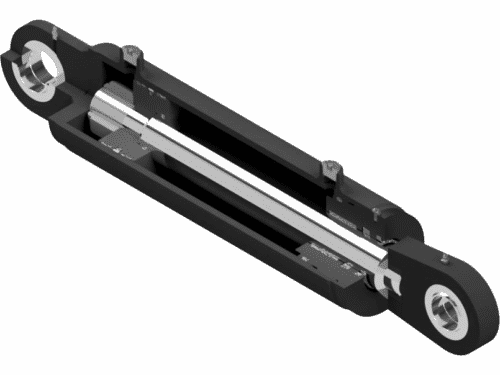Railways are not just an essential part of American commerce, but American history. In 1827, the first railway was laid for steam engines in Baltimore, Maryland. The first track was only 13 miles long and took three years to complete. By 1852, the Baltimore & Ohio (B&O) railroad was expanded to the Ohio River in Wheeling, West Virginia. For the next 100 years, these railways were laid entirely by hand, but when hydraulic cylinders were applied to rail equipment, rail expansion, and repair, was able to occur at a more rapid pace.
Of course, there are the obvious uses of hydraulic cylinders in the rail industry. Loaders and cranes to move equipment, and train cars, on and off tracks, as well as on loading and offloading goods for transport. There are several pieces of equipment however, that are used to build and repair track today, that use hydraulic cylinders to do the bulk of the work; tie cranes, spike drivers, ballast regulators, tie inserter/removers, and ballast tampers. Without this equipment, rail repair would be a labor-intensive process. Hydraulic cylinders have made it not only easier, but safer to do this work on America’s railways.
Tie cranes are used to lay down new, or remove old, railroad ties. These hydraulic crane type machines are often mounted on light rail car trolleys that can roll on the track they are working on. Fitted with a gripper utilizing hydraulic cylinders on the end of the lifting arm, a movable ‘wrist’ allows for the ties to be positioned precisely. Hydraulic cylinders allow the arms to be extended out in front of the existing rails, where future rail will be placed eliminating the need for manpower to place the ties along the route in often remote areas.
Tie inserter/remover is a rail mounted machine that can pull or place rail ties without the need to remove the track above them. This machine uses hydraulic cylinders to grab the exposed end of a rail tie. Another hydraulic cylinder then extends an arm outward and perpendicular to the track, pulling the tie out from underneath where it can be picked up by a tie crane. To place the tie, this process is repeated in reverse. This allows for a damaged tie to be replaced without the need for track to be removed along a route, eliminating the need to shut down a route for long periods of time.
Spike drivers have replaced traditional sledge hammers to drive the spikes that hold rail ties in place. Using a spike driver saves time, and eliminates over driving the spikes. Resembling a hydraulic cylinder with a handle on one end, and a socket for the rail spike on the other, a spike driver exerts downward force pushing a spike through a rail tie and into the earth below, holding the rail tie in place.
Ballast regulator is used to distribute and shape the gravel underneath rail ties and tracks. Hydraulic cylinders on this track mounted machine control a middle and two side blades that can push the gravel evenly to give the proper shape for an even track run to be laid. These machines often run over existing tracks to ensure track ballast (gravel) supports the tracks properly. The need for hydraulic cylinders that can change the depth of the blade, as well as it’s angle on each side is crucial for keeping the track level and within tolerances for straight or curved track runs.
Ballast tamper is a large track mounted machine that can pick up track and ties already laid, in large sections, and pack track ballast (gravel) below them. The mechanics and hydraulics involved in this type of machine are often complicated. As the machine moves over the track, it senses where ties have sunk from the weight of train cars, or erosion causing the track to sag. Hydraulic cylinders on the ballast tamper grasp the rail ties that have sunk, and another set of hydraulic cylinders lift them into place and ensure they are level. A third set of hydraulic cylinders then packs ballast back underneath the raised rails and ties to support them in their new position. While the tamper adjusts for height, it also adjusts to ensure that rails are parallel to each other and the track is as straight as possible. Without hydraulic cylinders this complicated process could take several days for a short section of track.
If you’re in the rail industry, or any industry that uses hydraulic cylinders, and you’d like more information on how Aggressive Hydraulics® can help with the pushing, pulling, and heavy lifting in your industry, contact one of our Hydraulic Cylinder Specialists® at (866)406-4100, or check out our railway maintenance page for more information.






